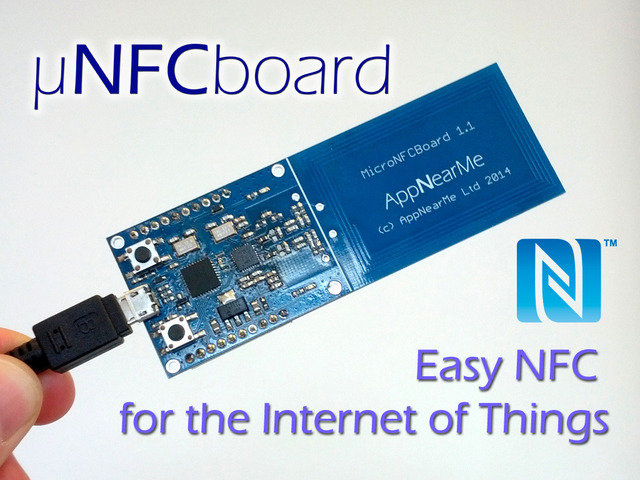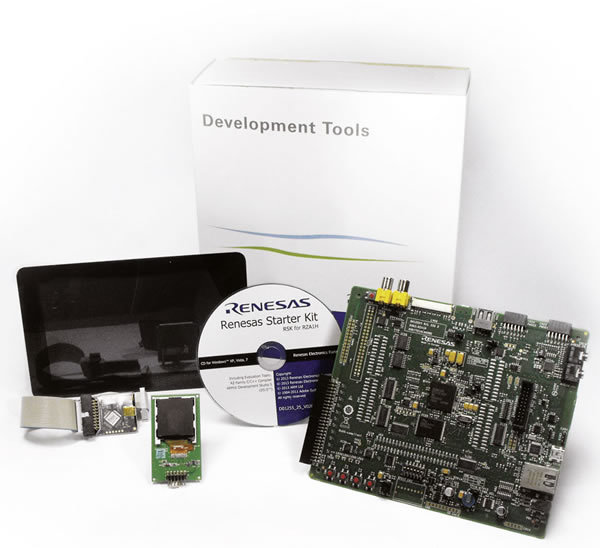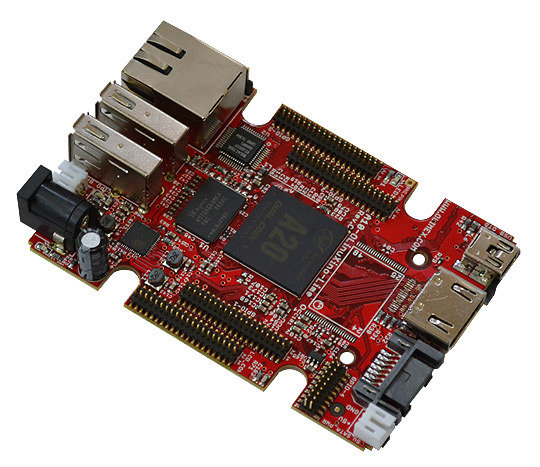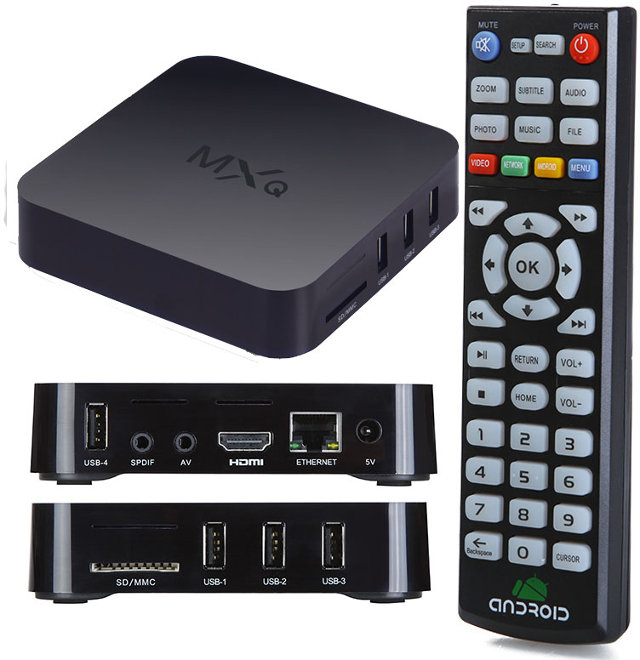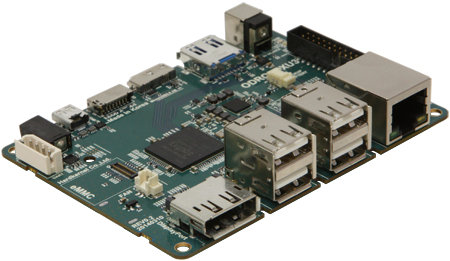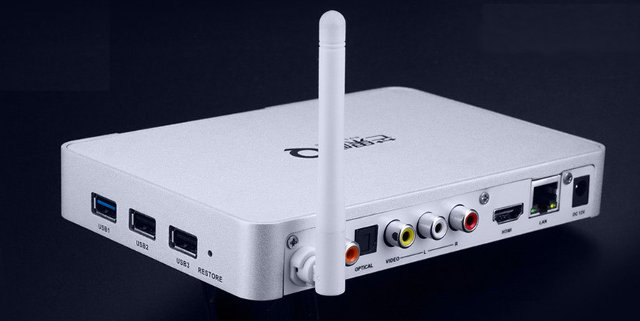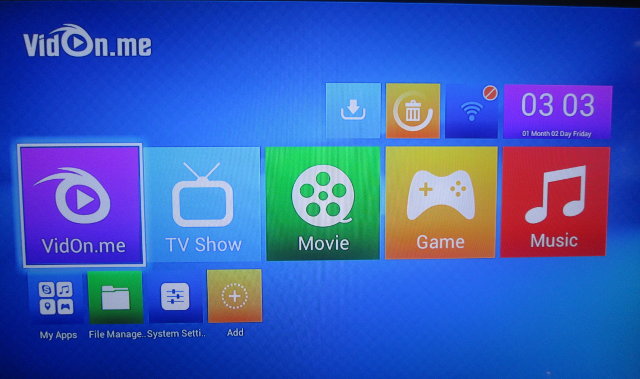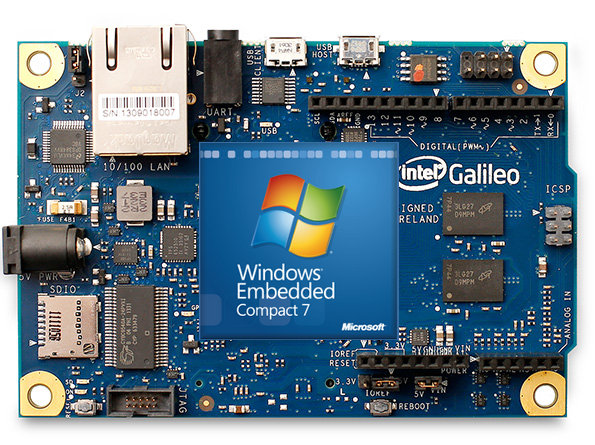AppNearMe MicroNFCBoard is a development platform for Near Field Communication (NFC) comprised of an NFC transceiver, an NXP MCU, and all software stack and tools you need for development. This board also exposes various I/Os that allows you to connect to external hardware or devices, and it can be used with an Arduino, Raspberry Pi, mbed or PC/Mac. Let’s go through the board specifications first: MCU – NXP LPC11U34FHN33/421 Cortex M0 MCU @ 48MHz, with 10KB RAM, 48KB FLASH, 4KB EEPROM NFC Transceiver – NXP PN512. Reader/Writer and card operation modes supporting ISO14443A/Mifare and FeliCa schemes. NFCIP-1 mode Splittable antenna USB – 1x micro USB port for power and programming I/O – 20x through holes with access to serial (UART), I2C, SPI, 4x ADC inputs, IRQ, Boot and Reset, and power pins. (2x pin header that you can solder are provided) Misc – Reset and bootloader enable push-buttons, 2x LEDs. […]
Renesas RZ/A1H Starter Kit and Emtrion DIMM-RZ System-on-Module Run Segger embOS RTOS or Linux with 10MB SRAM
Announced just about a year ago, Renesas RZ/A1 ARM Cortex A9 processor family can be used for human machine interface applications, and has the particularly to embed large amount of SRAM, especially the RZ/A1H series with 10 MB SRAM which allows the development of some applications without external RAM chip, lowering both board size and BoM cost. I’ve just come across a development kit dubbed “RZ/A1H Starter Kit”, and the just released Emtrion DIMM-RZ system-on-module both powered by Renesas RZ/A1H SoC. Renesas RZ/A1H Starter Kit+ (RSK) The development kit includes the mainboard, a 7″ TFT LCD (Optional), a detachable Colour LCD Board Pmod Compatible,a detachable AD Adjustment Shaft, Segger J-LINK Lite debugger, various connection cables, a power supply, a Quick Start Guide, and a DVD-ROM with documentation, ARM DS-5 IDE (with 32K code limit), KPIT GNU compiler for Cortex A9, Segger debugger drivers. and sample code. The mainboard has the […]
33 Euros Olimex A20-OLinuXino-LIME Open Source Hardware Board Supports Linux and Android
Last year, Olimex launched A10-OLinuxXino-LIME powered by AllWinner A10, and it became quite popular due to its Linux and Android support, its open source hardware, and a price tag of just 30 Euros that made it cost competitive with BeagleBone Black and Raspberry Pi boards. The company has now designed an upgrade with A20-OLinuXino-LIME powered by AllWinner A20 dual core Cortex A7 processor, that sells for just 3 Euros more. A20-OLinuXino-LIME specifications: SoC – AllWinner A20 dual core ARM Cortex-A7 @ 1GHz with Mali-400MP2 GPU System Memory – 512MB DDR3 Storage – microSD card slot, SATA, and optional 4GB NAND Flash Video Output – HDMI 1080p USB – USB-OTG + 2x USB Hosts Connectivity – 10/100Mbit Ethernet Expansions – 200 GPIOs on 0.05″ connectors Misc – Lipo battery management and connector, buttons Power – 5V Dimensions – 84 x 60 mm The specifications are exactly the same expect for the […]
Eny Technology Introduces EM6Q-MXQ Android STB Based on Amlogic S805 SoC
In the last few months, we’ve seen a few Amlogic S802 powered Android media players such as Tronsmart Vega S89, SZTomato/Eny M8, and MINIX NEO X8(-H), which have the fastest Cortex A9 processor on the market with a relatively powerful octa core Mali-450MP6 GPU, as well as 4K decoding and output capabilities. But if you’d like something a little more affordable, don’t care about 4K, and would do with a quad core SoC that’s not quite as powerful, but more power efficient, and still supports HEVC, you may consider one of the upcoming devices based on Amlogic S805. Eny Technology is one of the first company to announce an S805 media player with their EM6Q-MXQ. You can check S802 / S805 / S812 comparison for details. The enclosure and remote control both look pretty familiar, and the hardware specifications are quite similar to GBox Midnight MX2, except for the Amlogic […]
Hardkernel Unveils $179 ODROID-XU3 Development Board Powered by Samsung Exynos 5422 SoC
Remember ODROID-XU2 development board based on Exynos 5420? The bad news is that it apparently got scrapped, but the good news is that it gave birth to ODROID-XU3 development board powered by the latest Samsung Exynos 5422 octa core big.LITTLE SoC with support for Ubuntu 14.04 and Android 4.4, including GPU 3D acceleration with the company promising a full desktop experience in Ubuntu. ODROID-XU3 specifications: SoC – Samsung Exynos 5422 quad core ARM Cortex-A15 @ 2.0GHz+ quad core ARM Cortex-A7 @ 1.4GHz with Mali-T628 MP6 GPU supporting OpenGL ES 3.0 / 2.0 / 1.1 and OpenCL 1.1 Full profile System Memory – 2GB LPDDR3 RAM PoP (933Mhz, 14.9GB/s memory bandwidth, 2x32bit bus) Storage – Micro SD slot (up to 64GB) + eMMC 5.0 module socket (16, 32, or 64GB module available) Video Output – micro HDMI (Up to 1080p) and DisplayPort (up to 2160p) Audio Output – micro HDMI and […]
HiMedia Q5 Quad Core is an Android TV Box based on HiSilicon Hi3798C SoC with SATA, USB 3.0, 4K Support
HiMedia has been releasing and manufacturing Android TV boxes with SATA interfaces based on Hilison processors including Q5 (single core) and Q5II (dual core) for a couple of years. The company is about to release another one with the same enclosure, based on a new Hilicon Hi3798C quad core SoC, that they’ve aptly named “Q5 Quad Core”. HiMedia Q5 Quad Core specifications: SoC – HiSilicon Hi3798C quad core ARM Cortex A9 @ 1.5GHz + ARM Mali-450MP6 Octa core GPU. System Memory – 2 GB DDR3 Storage – 8GB eMMC Flash, SATA connector, and MMC/SD 2-in1 card reader Connectivity – 10/100/1000M Ethernet, and 802.11 b/g/n/ Wi-Fi with external antenna Video Out – HDMI 1.4 up to 4K30 and composite Audio Output – HDMI, L/R stereo (RCA), and optical & coaxial S/PDIF Video Codecs – MPEG1/2/4 up to 4K30, H.264/AVC up to 4K30, H.265 up to 4K30, VC-1, REALVIDEO 8/9/10 up to […]
VidOn.me AV200 Android TV Box Review
After providing some pictures of VidOn.me AV200 media player, and its PCBA, it’s now time for a review. I’ll start by giving my first impressions, and checking out the system settigns and user’s interface, go through my library of video test files, and cover most hardware features. As usual, I’ll also test Wi-Fi performance, but I’ve now added more tests including Ethernet performance, and USB hard drive support and performance with NTFS, FAT32, EXT-4, and BTRFS partitions. First Boot, Settings and First Impressions The device comes with an IR remote control with lots of buttons, including shortcuts, D-Pad control, digit keys and trick modes (play/pause, fast forward and rewind, next and previous), but the two required AAA batteries were not included, and I did not have spare batteries, so I did not use the remote control, which looks pretty OK for XBMC, and just control the device with my Mele […]
Microsoft is Giving Away Intel Galileo Arduino Compatible Boards to Developers
Microsoft has already launched several initiatives to reach the maker movement and app developers with .NET Gadgeteer supported by platform like Bambino 200, as well as Intel Shark Cove development board for Windows development. The company has now launched a website called windowsondevices.com where they currently have a signup page for developers to send a kit based on Intel Galileo, an Arduino compatible board powered by Intel Quark processor. There’s currently very little information on the software and documentation part of the development kit, but there are links to Visual Studio Express, Windows Embedded’s Internet of Things page, and a link to Maker Faire, so it gives what the kit will be for. Apparently they’ll send the kit to selected candidate whether “you are an experienced Windows developer looking to jump into the Internet of Things or you are new to Windows development and want to build the next big […]


